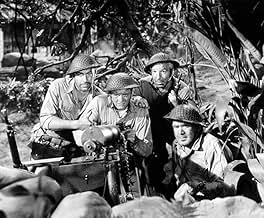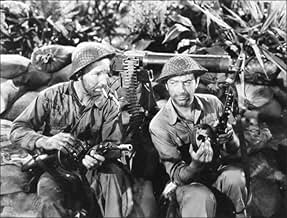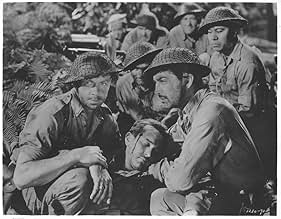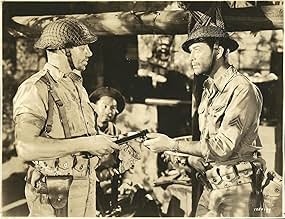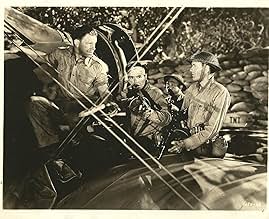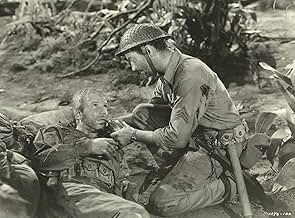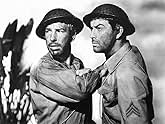Agrega una trama en tu idiomaIn 1942, in the Bataan peninsula of the Philippines, a ragtag American unit commanded by Sergeant Bill Dane attempts to blow-up a bridge in order to slow the Japanese advance.In 1942, in the Bataan peninsula of the Philippines, a ragtag American unit commanded by Sergeant Bill Dane attempts to blow-up a bridge in order to slow the Japanese advance.In 1942, in the Bataan peninsula of the Philippines, a ragtag American unit commanded by Sergeant Bill Dane attempts to blow-up a bridge in order to slow the Japanese advance.
- Dirección
- Guionistas
- Elenco
- Premios
- 5 premios ganados en total
- Yankee Salazar
- (as J. Alex Havier)
- Wounded Soldier
- (sin créditos)
- Japanese Soldier
- (sin créditos)
- Japanese Soldier
- (sin créditos)
- Infantry Soldier
- (sin créditos)
- Dirección
- Guionistas
- Todo el elenco y el equipo
- Producción, taquilla y más en IMDbPro
Opiniones destacadas
NOTE: A previous persons comment stated that they were not even wearing American helmets. In fact, the helmets worn in the movie ARE correct for the American Army in the early 1940's.
Rather than try to show the entire evacuation and abandonment of the Phillipines, which would be perhaps overwhelmingly depressing, the film-makers decided to focus on one small, fictional incident that could, in effect, stand in for everything else. They chose wisely. What happens is that we watch a group of soldiers defend and then destroy a bridge, so as to slow down the Japanese army's advance, if only by a few hours, to buy precious time for everyone else. None of these men wants to be a hero. They're all stuck there, and would rather be someplace else. While some are more aggressive than others, no one is wholly brave; and though there is a good deal of nervousness and occasional cowardice, they all pull together admirably in the end.
Though filmed on the Culver City lot, the film cleverly and expressionistic ally suggests a tropical environment. As the story progresses the jungle gets foggier. It was never too inviting to begin with; by the movie's end it is absolutely forbidding.
The acting is variable. Some of the casting is peculiar. Thomas Mitchell plays a corporal named Feingold, but can't seem to get rid of the slight, American-style brogue that was so much a part of his screen persona. Desi Arnaz has a small role. There is a fairly straightforward presentation of a black man whose color is the least important thing about him. Robert Walker, in what I believe is his first film, has a showy role as a garrulous, yarn-spinning sailor. His character is, I imagine, supposed to be a typically charming, bumptious All-American boy, along the lines, perhaps, of Van Johnson. I find Walker,--who was an excellent actor--obnoxious in the part. Lloyd Nolan is tough as nails as a hard-case soldier with a dark past.
The movie's biggest asset in the acting department also happens to be its star: Robert Taylor. This pretty boy matinée idol gives a fine performance as the sergeant with a job no man in his right mind would want. And he is in his right mind. Taylor has no vanity in the part. He is as dirty and unshaven as everyone else in the cast, and at times shows flashes of depth and insight that are startling given his lightweight reputation. Taylor pulls the film together, with no Duke Wayne ostentation or posturing, and proves, like the film, to be stronger and truer to life than we might at first have imagined.
This classic warlike movie is nicely starred by Robert Taylor at one of his best roles as a tough sergeant , he's accompanied by a plethora of first-rate secondaries . This exciting actioner warfare completed with slice of military stereotypes although some characters are very one-dimensional , as well as presenting an African American in an intelligent and sympathetic manner , attempting to avoid any racial speeches in the script . The original plot belongs to ¨Lost patrol¨ (1934) by John Ford , whose screenplay has been pretty imitated and remade many times but it's still a magnificent entertainment . In fact , Metro-Goldwyn-Mayer paid RKO a lot of money for the right to use scenes from Lost patrol in this movie . As ¨Lost patrol¨ was subsequently remade and reworked several times : ¨Sahara¨ (by Zoltan Korda) with scenarios in Libya desert ; ¨Last of Comanches¨ (Andre De Toth) in California desert ; and even part of ¨Flight of Phoenix¨ (Robert Aldrich) in Sahara desert , and , of course , this ¨Bataan¨(Tay Garnett) in Philippines jungle . This is one of a handful of feature films that have featured the story of the World War II Battle of Bataan , they include ¨So proudly we hail¡¨ by Mark Sandrich (1943) ; ¨They were expendable¨ (1945) by John Ford and ¨Back to Bataan¨ (1945) by Edward Dmytryck . The film is set into a lush , abundant jungle with a dense fog made by usual Metro Goldwin Mayer production designer , Cedric Gibbons , and it contains an atmospheric as well as thrilling musical score by Bronislau Kaper . The motion picture was professionally directed by Tay Garnett, a good Hollywood craftsman.
The actual deeds about Bataan concern an unsuccessful attempt by US and Filipino troops under General Douglas MacArthur to defend the peninsular against the Japanese 1 Jan-9 April 1942 . Following the surrender of Bataan , MacArthur was evacuated , but Allies captives were force-marched 95 km/60 mi to the nearest railhead in the Bataan Death March,ill-treatment by the Japanese guards during the march killed about 16.000 US and Filipino troops .
After the Japanese invasion of the Philippines in December 1941 and the fall of Manila (January 2, 1942), the defending Americans and Filipinos withdrew to Bataan, foiling Japanese efforts to split the forces of U.S. General Douglas MacArthur... His troops fought a fierce delaying action until April 9, 1942, and remnants, led by Lieut. Gen. Jonathan M.Wainwright, escaped to Corregidor Island, where they surrendered about a month later...
On January 9, 1945, U.S. Forces, under MacArthur, landed at Lingayen Gulf to the north and sealed off the Bataan Peninsula... Landings were then made at Mariveles Harbor in the south and on Corregidor Island, thus securing Manila Bay for the U.S. Navy...
"Bataan" is the fictional story of 13 men who stayed behind, holding a bridge, and fighting to the death a rear guard action to ensure the success of the Allied forces retreat from the Philippines...
The audience live with the soldiers their last heroic days: George Murphy, an Air Force Lieutenant secretly reliable; Lloyd Nolan, the smart Corporal with compassionate qualities; Thomas Mitchell, a career NCO; Deni Arnaz, a friendly Spanish soldier; Barry Nelson, the competent Matowski; Lee Bowman, the Captain who falls with a bullet; Robert Walker (in his screen debut) who almost breaks down from homesickness; Kenneth Spencer, the black soldier with an undisturbed force and simple dignity, and Robert Taylor, the tough heroic Sergeant alive in the face of the enemy, who sets up his machine gun and keeps it firing until the end...
All are representatives of the heroism existing in all Americans, symbol of the heroic resistance...
¿Sabías que…?
- TriviaPrologue: "When Japan struck, our desperate need was time--time to Marshall our new armies. Ninety-six priceless days were bought for us--with their lives--by the defenders of Bataan, the Philippine army which formed the bulk of MacArthur's infantry fighting shoulder to shoulder with Americans. To those immortal dead, who heroically stayed stayed the wave of barbaric conquest, this picture is reverently dedicated."
- ErroresAlthough the American soldier was clearly a great coconut tree climber, it is near to impossible to sit atop a coconut tree. Many Filipinos to this day fall when attempting this.
- Citas
Sergeant Bill Dane: Come on, suckers! What's the matter with you? What are you waitin' for? Didn't think we were here, did you? You dirty rotten rats! We're still here! We'll always be here! Why don't you come and get it?
- Créditos curiososClosing credits epilogue: So fought the heroes of Bataan. Their sacrifice made possible our victories in the Coral and Bismark Seas, at Midway, on New Guinea and Guadalcanal. Their spirit will lead us back to Bataan!
- Versiones alternativasAlso available in a computer colorized version.
- ConexionesFeatured in Toast of the Town: A Salute to Lucy and Desi (1954)
- Bandas sonorasSt. Louis Blues
(1914) (uncredited)
Music and Lyrics by W.C. Handy
Sung a cappella and hummed often by Kenneth Spencer
Selecciones populares
- How long is Bataan?Con tecnología de Alexa
Detalles
Taquilla
- Presupuesto
- USD 958,000 (estimado)
- Tiempo de ejecución1 hora 54 minutos
- Color
- Relación de aspecto
- 1.37 : 1
Contribuir a esta página



